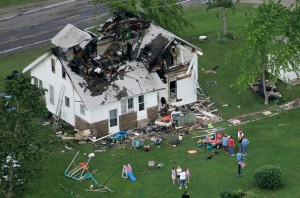Doctor stresses lightning preparedness locally, globally
Kevin Beese — April 27, 2015If it weren’t for moving her parents four times in a year, Dr. Mary Ann Cooper would likely be in Tucson or up in the mountains of Boulder, Colo., with a picturesque view of storms rolling in.
Ever since childhood, Cooper, now an international expert on lightning injuries, has loved storms.
“My father loved lightning and he said his kids were not going to hide under the bed (when storms rolled in),” Cooper said. “So we watched the storms. For us, it was like the Fourth of July.”
Through her medical training, research into lightning victims and work as a Kentucky doctor consulting on lightning strike patients, Cooper, now of River Forest, has become a source of information for media, medical personnel and the families of lightning victims.
She has played a role in at least 18 Discovery Channel programs and 20 National Geographic Channel programs, She has appeared on “20/20,” “CBS News with Connie Chung,” and public radio around the world. She has gotten emails about lightning strikes from nearly every country imaginable, including Romania, Hong Kong and China
Her message is a simple one: “When thunder roars, head indoors.”
Through her and other lightning experts’ efforts, lightning deaths have dropped to about 25 per year in the United States.
“We have changed what people do,” Cooper said. “We have taught kids for generations. Why do people watch the news? It is not for the news, They get that all day. It is for the weather. So they know how to dress their kids for school. And when Tom Skilling says there will be storms in the area, parents pay attention to that.
“We have changed things. Lightning deaths are not in the hundreds any more.”
Cooper doesn’t see the annual fatality rate from lightning strikes in the United States dropping much below 25
“There will still be 25 a year,” Cooper said. “There are always the stories of someone mowing his lawn and not hearing the thunder, or listening to an mp3 player, or not getting reception on their cell phone at the mall and going outside for better reception and getting struck.”
Two North Carolina residents died in separate lightning strikes earlier this month — the first U.S. lightning fatalities in 2015.
Cooper said where the United States was a century ago with its lightning fatality rates is where developing nations in Africa and other countries are now.
That is why Cooper is part of the “Lightning Kills: Save a Life in Africa” project, an effort that is looking to put lightning rods at African schools that have already sustained a lightning strike.
“Things are always five times more difficult than they should be (in African countries),” Cooper said. “There are four schools that we want to do first, one where 18 students and a teacher were killed in 2011.”
Cooper said even though Americans are quicker to take precautions when lightning is in the area, she said there still are fallacies that exist about lightning, such as that strikes only happen in the middle of a storm.
“Lightning can hit from 10 or 15 miles away,” Cooper said. “It doesn’t have to be raining. It can be a clear sky.
“Also, seeing lightning is not as reliable as hearing thunder. You can only hear things from 10-12 miles away. So you are already in danger.”
She said people also wrongly believe that metal attracts lightning.
“Nothing attracts lightning,” Cooper said.
She added that there is no added risk of being on a cell phone during a storm.
“Cell phones do not attract lightning,” she said. “There are the same dangers being on your cell phone during a storm as being on your cell phone crossing the street. You are not paying attention because you are on your phone. So you are not paying attention to what is going on around you.”
Cooper said that there is no place safe outdoors when there is thunderstorm in the area.
“You decrease your chance of being struck 100 percent, if you start evacuating (from outdoors) as soon as you hear the thunder,” she said.
Cooper said moving her parents four times in 12 months made the decision for her to stay put in River Forest once she retired from medicine instead of going somewhere with better views of incoming storms.
A recent encounter with a new neighborhood resident made Cooper realize the impact she has helped have on storm preparedness. She was clearing a storm drain in front of her corner lot between storms when a young woman who had just moved in came walking by with her dog.
“She said she wanted to get out with the dog because once she heard the thunder, she was heading indoors,” Cooper said. “She didn’t know me at all, but she knew my message.”
You can get information about Cooper’s efforts to improve lightning preparedness in developing countries by emailing her at macoooper@uic.edu.










